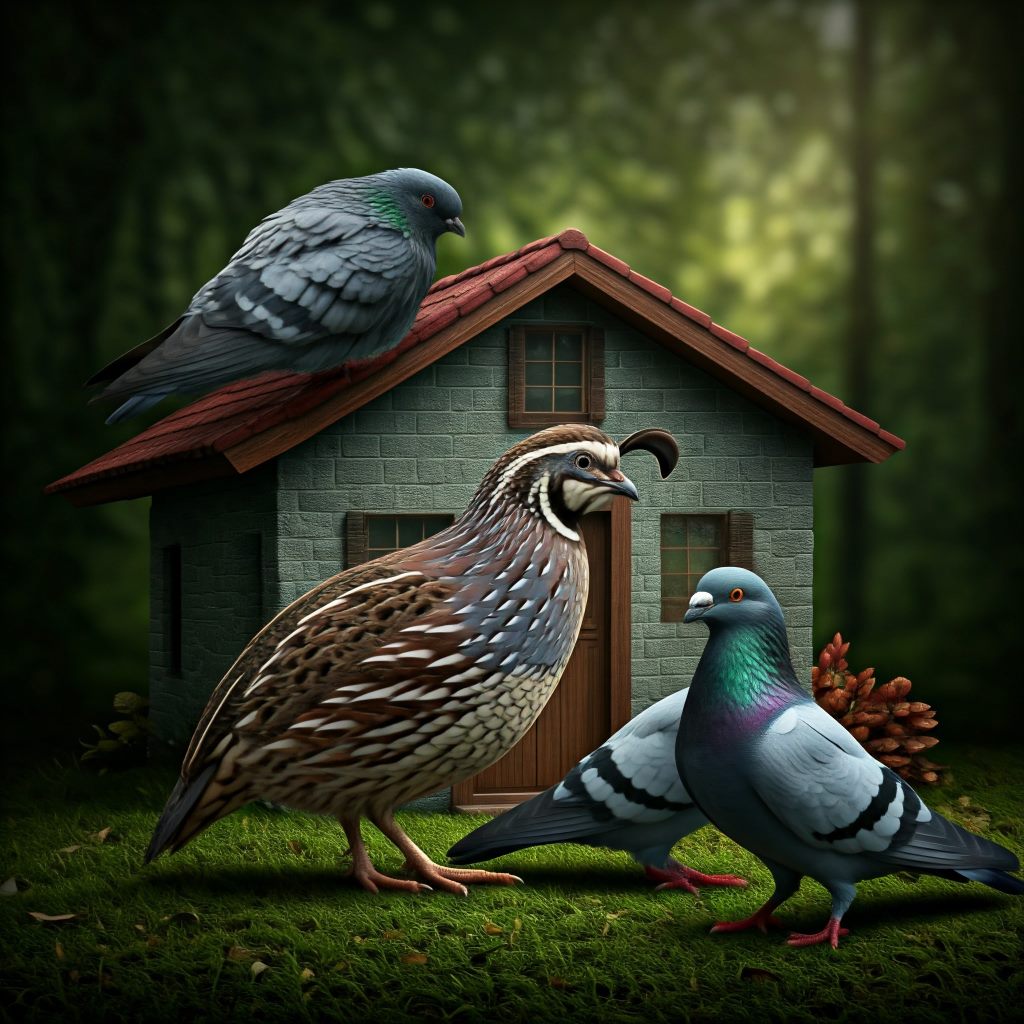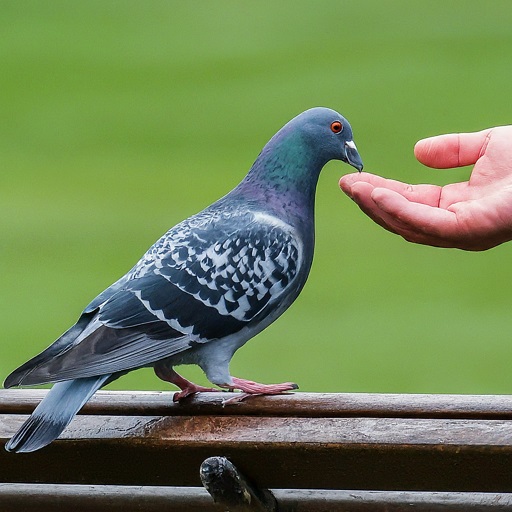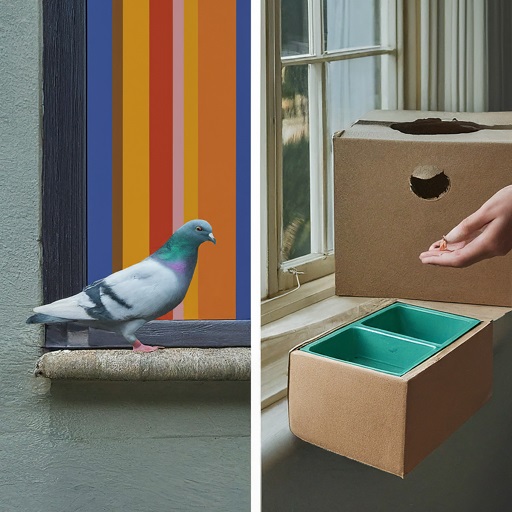Can You Keep Quails and Pigeons Together? (Answered)
Poultry enthusiasts often face the dilemma of whether different bird species can be housed together. Quails and pigeons, while both being popular choices for backyard aviaries, have unique characteristics and needs. Understanding these can help determine if they can coexist harmoniously in a shared space. This article explores the pros and cons, challenges, and best practices for keeping quails and pigeons together.
Understanding Quails and Pigeons: Characteristics and Behaviors
Quails
Quails are small, ground-dwelling birds known for their compact size, rapid growth, and prolific egg-laying. They are often raised for their meat and eggs, but also kept as ornamental birds. Quails are generally calm, although they can become stressed easily due to their skittish nature.
Key Characteristics:
- Size: Small, typically 6-7 inches in length.
- Behavior: Ground-dwellers, prefer nesting and foraging on the ground.
- Diet: Primarily seeds, grains, and insects.
- Social Structure: Often kept in pairs or small groups, can be territorial.
Pigeons
Pigeons are medium-sized birds known for their homing ability and social behavior. They have been domesticated for centuries and are kept for various purposes including racing, message delivery, and as pets.
Key Characteristics:
- Size: Medium, generally 11-14 inches in length.
- Behavior: Highly social, prefer perching and nesting in elevated areas.
- Diet: Seeds, grains, and occasionally fruits and vegetables.
- Social Structure: Usually kept in pairs or flocks, can be territorial but are generally more adaptable to social environments.

Housing Quails and Pigeons Together: Pros and Cons
Pros:
- Space Efficiency: Combining species in one aviary can save space, especially useful for urban or limited-space settings.
- Diversity and Enrichment: Mixed-species aviaries can provide a more stimulating environment for birds, mimicking a more natural ecosystem.
- Economic: Reduced need for multiple enclosures can lower costs related to materials, maintenance, and space usage.
Cons:
- Different Habitat Preferences: Quails are ground-dwellers while pigeons prefer elevated perches. This requires a well-designed aviary to accommodate both species.
- Dietary Differences: While their diets overlap, quails require more protein from insects, whereas pigeons thrive on grains. Feeding management needs to be precise to ensure both species’ nutritional needs are met.
- Health Risks: Mixed species can lead to the spread of diseases unique to one species but harmful to the other. Ensuring a clean and disease-free environment is crucial.
- Behavioral Conflicts: Territorial disputes can arise, especially during breeding seasons. Understanding each species’ behavior is essential to minimize stress and aggression.
Best Practices for Keeping Quails and Pigeons Together
Housing Design
A well-planned aviary can significantly reduce potential conflicts and enhance the well-being of both quails and pigeons. Consider these design elements:
- Separate Zones: Create distinct areas for ground-dwelling quails and perching pigeons. Elevated perches, roosting spots, and nesting boxes for pigeons can coexist with ground hides and nesting areas for quails.
- Adequate Space: Ensure the aviary is spacious enough to prevent overcrowding. Both species should have ample room to move, forage, and retreat from each other.
- Safe Barriers: Use dividers or barriers to segregate feeding and resting zones if necessary. This can help prevent competition and aggression.
Feeding Strategies
Managing the dietary needs of quails and pigeons together requires careful planning:
- Separate Feeding Stations: Provide multiple feeding stations to reduce competition. Ensure quails have access to protein-rich food and pigeons to grains.
- Varied Diet: Incorporate a variety of seeds, grains, and protein sources such as mealworms for quails. Pigeons may benefit from occasional fruits and vegetables.
Health and Hygiene
Maintaining a clean and disease-free environment is critical:
- Regular Cleaning: Keep the aviary clean and dry to prevent the spread of diseases. Regularly clean feeders, waterers, and perching areas.
- Health Monitoring: Regularly check both quails and pigeons for signs of illness. Consult a veterinarian with experience in avian health for any concerns.
- Biosecurity Measures: Implement biosecurity measures to prevent the introduction of pathogens. Quarantine new birds before introducing them to the aviary.

Case Studies and Experiences
To provide a well-rounded view, let’s explore some case studies and experiences of bird keepers who have successfully housed quails and pigeons together:
Case Study 1: Urban Aviary
In an urban setting, a bird enthusiast managed to create a harmonious environment for quails and pigeons. By using vertical space efficiently with elevated perches and creating ground cover for quails, the aviary allowed both species to thrive without interfering with each other. Regular health checks and a varied diet ensured the well-being of all birds.
Case Study 2: Backyard Homestead
On a small homestead, a mixed-species aviary was designed with separate feeding stations and nesting areas. The quails, benefiting from ground-level hides, coexisted peacefully with pigeons perched above. The key to success was monitoring for any signs of stress or illness and adapting the environment accordingly.
Expert Opinions
Dr. Emily Birdswell, Avian Veterinarian
“Combining quails and pigeons in one aviary can be done successfully with careful planning. The primary concerns are ensuring that the habitat meets the needs of both species and that health protocols are strictly followed. A clean environment and adequate space are vital to prevent disease and stress.”
John Featherstone, Aviary Designer
“A mixed-species aviary offers a dynamic and visually appealing environment. The design should prioritize vertical space to accommodate pigeons and ground cover for quails. Flexibility in the design allows adjustments based on the birds’ behavior and needs.”
Common Challenges and Solutions
Aggression and Territorial Behavior
- Challenge: Both quails and pigeons can display territorial behavior, leading to aggression.
- Solution: Provide ample space and clearly defined territories. Separate feeding and nesting areas can reduce competition. Monitoring during breeding seasons is crucial to mitigate conflicts.
Disease Management
- Challenge: Mixed-species aviaries can increase the risk of disease transmission.
- Solution: Maintain strict hygiene practices, including regular cleaning and disinfection. Quarantine new birds and regularly monitor for signs of illness. Vaccinations and regular veterinary check-ups are recommended.
Nutritional Balance
- Challenge: Meeting the distinct dietary needs of quails and pigeons in a shared environment.
- Solution: Provide a varied diet with species-specific nutritional supplements. Separate feeding stations ensure that each species can access its required nutrients without competition.

What Else Can We Keep With Pigeons
There are a variety of birds and animals that can coexist with pigeons in a shared space, provided you take their specific needs and behaviors into account. Here are some potential companions for pigeons:
Doves
Doves are closely related to pigeons and share similar care requirements. They are social, gentle birds that can often coexist peacefully with pigeons.
Finches
Finches are small, active birds that can get along with pigeons if the aviary is large enough. They need plenty of space to fly and forage.
Canaries
Canaries, like finches, are small and can coexist with pigeons in a well-designed aviary. They are more delicate and need their own safe perching areas away from the larger pigeons.
Budgerigars (Budgies)
Budgies are small parrots that can sometimes be kept with pigeons if introduced carefully and housed in a spacious aviary. They are social and curious birds.
Chickens
Chickens and pigeons can coexist in a large, well-maintained aviary or coop. Chickens are ground-dwellers like quails, so the setup should ensure there’s no competition for nesting spaces.
Turkeys
Turkeys, being larger birds, can sometimes share space with pigeons if there’s enough room and resources. They need ample ground space and separate feeding areas.
Ducks
Ducks can be housed with pigeons if the space is large enough and includes water features for the ducks. The aviary needs to be designed to accommodate both species’ needs.
Rabbits
Rabbits can share an aviary with pigeons as they are ground-dwellers and generally non-aggressive. Ensure there are hiding spots and separate feeding areas for the rabbits.
Guinea Pigs
Guinea pigs can also live in an aviary with pigeons. They are gentle and benefit from a spacious, enriched environment. Provide separate areas for food and hiding.
Important Considerations
- Space and Habitat: Ensure the aviary or enclosure is large enough to provide separate zones for each species. Birds and animals need space to move, forage, and retreat from each other.
- Dietary Needs: Different species have unique dietary requirements. Separate feeding stations and careful management of their diets are crucial.
- Behavioral Compatibility: Monitor interactions to ensure there is no aggression or stress among the different species.
- Health and Hygiene: Maintain cleanliness to prevent the spread of diseases. Regular health checks and vaccinations are important for all species.
By carefully planning and providing a well-designed environment, you can create a harmonious multi-species aviary that enriches the lives of your pigeons and their companions. If you have any specific questions or need more detailed advice, feel free to ask! 😊
Conclusion
In conclusion, keeping quails and pigeons together is possible with thoughtful planning and diligent care. Understanding the unique needs and behaviors of each species is paramount. By creating a well-designed aviary, managing their diets carefully, and maintaining a clean, disease-free environment, these birds can coexist harmoniously. Whether in an urban setting or a backyard homestead, a mixed-species aviary can offer a fascinating and enriching experience for both the birds and their keepers.
Should you decide to embark on this avian adventure, remember that patience, observation, and adaptability are key. With the right approach, your quails and pigeons can live together happily, adding a touch of nature’s charm to your daily life.
I hope this detailed guide helps you in your endeavors! If you have any more questions or need further assistance, feel free to ask. 😊






